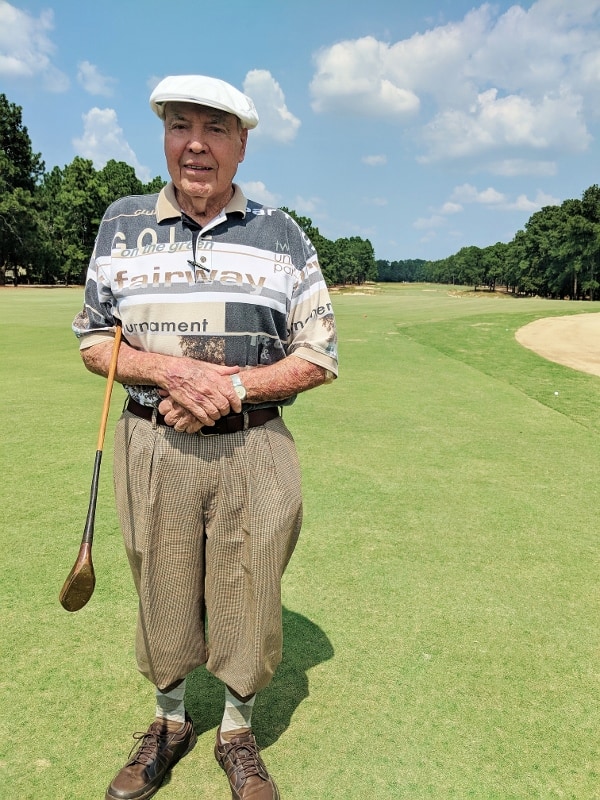By Alex Podlogar
The words come at you in a blur. The names. The dates. The clubs. The eyes dart one direction, then the other. Another story comes. Another memory.
Palmer Maples Jr. talks fast. He walks fast. Everything is fast. One moment, he walks outside and leaves behind his sister. But there’s something hereditary about it all, because in a flash Nancy, at 83, slips through the door, zooms across the veranda, and is down to the first tee of Pinehurst No. 2 in step behind her brother just as he, three years older, is arriving there.
He has five clubs in his bag, four of them with hickory shafts and another with a steel shaft coated in patina. He’s back in Pinehurst because of these clubs, two of them in particular.
He wants to take them to the tee.
“I’d like to putt a little, too,” he says.
The Maples family is among the most important in the history of American golf, and many of them had significant ties to Pinehurst. Palmer Jr. can tell you about all of them, and in dizzying detail. Frank, Henson, Angus Patrick, his father Palmer, Ellis, Dan…he can go on and on. And on.
Those names. Those dates.
Those clubs.

Palmer Maples Jr., 86, stands near the first tee of Pinehurst No. 2 holding a club made by Old Tom Morris, given to Maples’ father by Donald Ross.
He carefully pulls one out of the bag. The clubhead is no bigger than Maples’ fist, but it remains smooth around the edges. It’s marked, but not chipped, and the shaft still feels sturdy.
Maples cradles the club – the way golfers do – and stands on the first tee of No. 2.
And finally, he slows.
The pause lingers. The Village Chapel chimes are the only sounds for what feels like an eternity.
Maples begins, “Pinehurst is…” But, for the first time, he comes to a full stop.
He collects himself, the club still nestled in his arms. He starts again.
“Pinehurst is where my Daddy learned everything he knew,” Maples says. “And it’s where he taught me about living a life.”
The club Maples clings to was a gift to his father in 1923. The elder Palmer was 17 years old when he received the gift and it marked a special occasion – he had just finished his apprenticeship. Palmer had done a masterful job, and he was rewarded for it.
And so Donald Ross gave Palmer a gift.
It was an old club even then. Ross had brought it over the Atlantic with him 1900.
The club was made by Old Tom Morris in 1875.
“I was taught to honor God, about how to take care of a family, about looking out for your friends and being there to help whenever someone calls. It goes back to him.”
Maples pauses again. The words are carefully, thoughtfully chosen now.
“Those were the lessons Daddy got from Donald Ross. Daddy gave them to me.”
Maples puts his Daddy’s gift back in the bag and pulls out another club. The clubhead is noticeably larger and the shaft is metallic – advances in technology, no doubt.
This one dates back almost 100 years, and it’s every bit as cherished as the Old Tom club. This club is one Maples’ father built, carefully incorporating the other lessons Ross taught him – those of the game of golf and club-making.
Maples tees a ball on No. 2 and lets his father’s clubhead waggle. And with the sweetest tempo you ever did see, smacks a looping little draw down the first fairway.
“That’s how my Daddy taught me.”
It doesn’t take long – it’s no surprise Maples plays fast, too – and he’s on the first green with a hickory-shafted putter in his hands.
Nancy is there with him.
She tends the flag.

